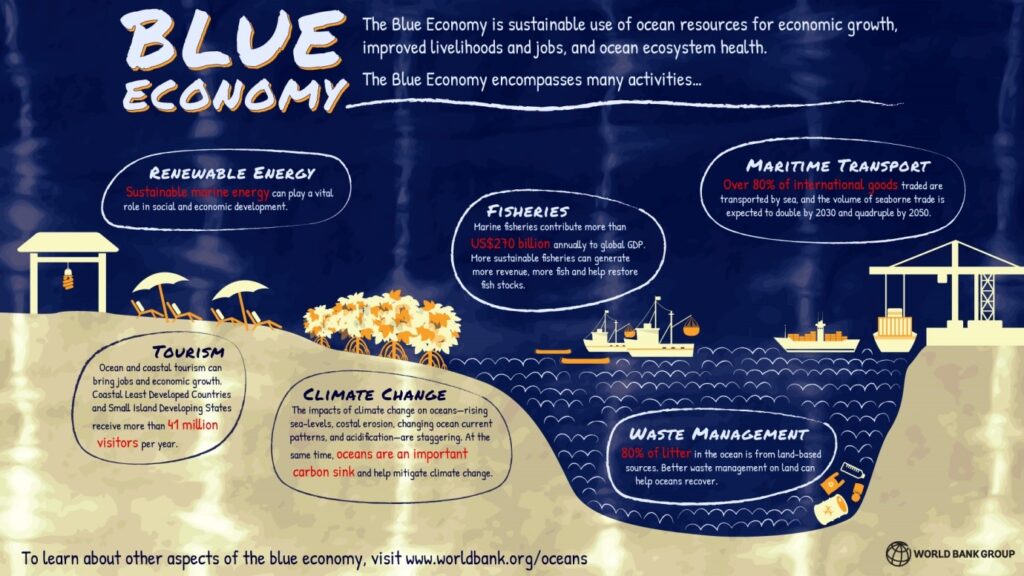By Sanya Saxena, Research Associate l March 21, 2022
Our planet is bestowed with blessings inherent in all its natural resources since its very beginning. One of its many natural resources are the blue waters; the streams, rivers and the ocean. Humans have utilized many resources and civilized into an expansive economy. But the potential of improving yet remains. The disguised blessing of the deep, blue oceans is yet to be fully explored. This is what we call the blue economy or what the European Commission defines as “All economic activities related to oceans, seas and coasts”.
“Blue Economy is the sustainable use of ocean resources for economic growth, improved livelihoods, and jobs while preserving the health of ocean ecosystem.”

Source: World Bank
Benefits of the Blue Waves globally
The blue economy is a big treasure box bestowed with market-rich opportunities. The market value derived by US companies by offering goods and services related to ocean observation, measurement and forecasting is estimated at US$7bn per year. In the EU, the employment generation from the blue economy was roughly 4.5 million people in 2018; attributing to about $149bn in economic value-added. As per a research commission of sustainable ocean economy; co-chaired by the Norwegian Prime Minister, “every dollar invested in the key ocean activities yields five times i.e. $5 in return; and is most cases, exponentially more.” Additionally, OECD estimates that the global value-added by ocean-based industries—including tourism, energy production, shipping, fishing and fish processing, and aquaculture—will multiply (x2) to US$3trn by 2030, up from US$1.5trn in 2010.
It also gives provision for the protection and development of more intangible ‘blue’ resources such as carbon sequestration and coastal resilience to help vulnerable states mitigate devastating effects of climate change.
The Blue economy maps an inclusive model where those coastal states which underutilize the ocean resources due to lack of managing capabilities can strategize a method to extend the benefit of those resources to the world. It also fulfils the aim of raising demand for renewable energy by exploiting the potential of offshore regions in the form of offshore wind, waves, ocean currents including tidal currents, and thermal energy.
There are a plethora of sectors streaming from the blue economy which will be able to employ a large workforce in more than just the immediate sectors such as fishing, aquaculture, fish processing, marine tourism, shipping and port activities but also from downstream and upstream maritime enterprises and industries that leverage these resources to produce other goods and services.
Benefits to India
India has a 7,500-km-long coastline spread across 9 coastal states, 4 Union Territories and is dotted with 12 major, and 200 minor ports and numerous fishing harbours. It has about 1300 Islands and several locations for Offshore drilling. Indian blue economy supports 95% of the country’s business through transportation and attributes to an addition of an estimated 4% to its GDP. With this is in mind, the Government of India document “Vision of New India by 2030”, highlighted the Blue Economy as one of the top ten fundamental dimensions of economic growth.
Indian measures to reach the higher step on the Blue Economic Ladder
Blue Recovery in response to COVID-19 pandemic led to a COVID Crisis report highlighting five blue stimulus actions to spur recovery and build a sustainable ocean economy. The stimulus package involves investments in coastal and marine ecosystem protection; sewage and wastewater infrastructure for coastal communities; sustainable marine aquaculture and incentives for zero-emission marine transport; and, renewable energy. Another aspect was for ‘international cooperation’ whereby researchers and officials will cooperate to improve the governance of ocean resources through marine spatial planning (e.g. in India-Norway Integrated Ocean Management Initiative. Then comes ‘education in Blue Economy’ which focuses on raising the number and type of educational programmes on the traditional and emerging sectors of the blue economy to be offered at institutions (engineering/technical) for creating a resource pool of trained personnel. Finally, the Gandhian approach is to be followed. Itbalances economic benefits with sustainability for meeting the objectives in economic growth, employment generation, equity and protection of the environment.
Loopholes in harnessing the economic value of the Blue Waves
Ocean data is one of the most crucial inputs required to fully harness the ocean’s economy and to identify new maritime opportunities. It provides critical inputs for maritime activities and businesses, better cost savings and profits generation. For case in point, marine transport is supported by forecasting of weather and ocean conditions, and energy production activities—from oil and gas to offshore wind solar and thermal energy — which are heavily reliant on detailed offshore data to support infrastructure siting and design. Ralph Rayner, professorial research fellow at the London School of Economics and past president of the Society for Underwater Technology, commented that “without ocean observation data, and in turn the information and knowledge that it generates, you cannot sustainably use the ocean or ocean resources. It’s not possible to even define what sustainable means without ocean data.” Moreover, this ocean data can become a more valuable economic product in its own right, though this potential is barely explored.
Conclusion
The ocean evidently has a big role to play in strengthening resilience to economic and environmental disruptions. Capitalizing in shipping decarbonisation, sustainable seafood production and ocean-based renewable energy provides for improved health outcomes, more affluent biodiversity, more sheltered jobs and a benign planet for the coming generations. The ocean is the future as it exploits a sustainable way of life for all ahead. India has tremendous opportunities to leverage its sea based geography. But, this requires at the very minimum a National Marine Spatial Plan based on hard data so that every inch of the sea areas is planned for appropriate activities that will help India ride the Blue Waves to a Green World.